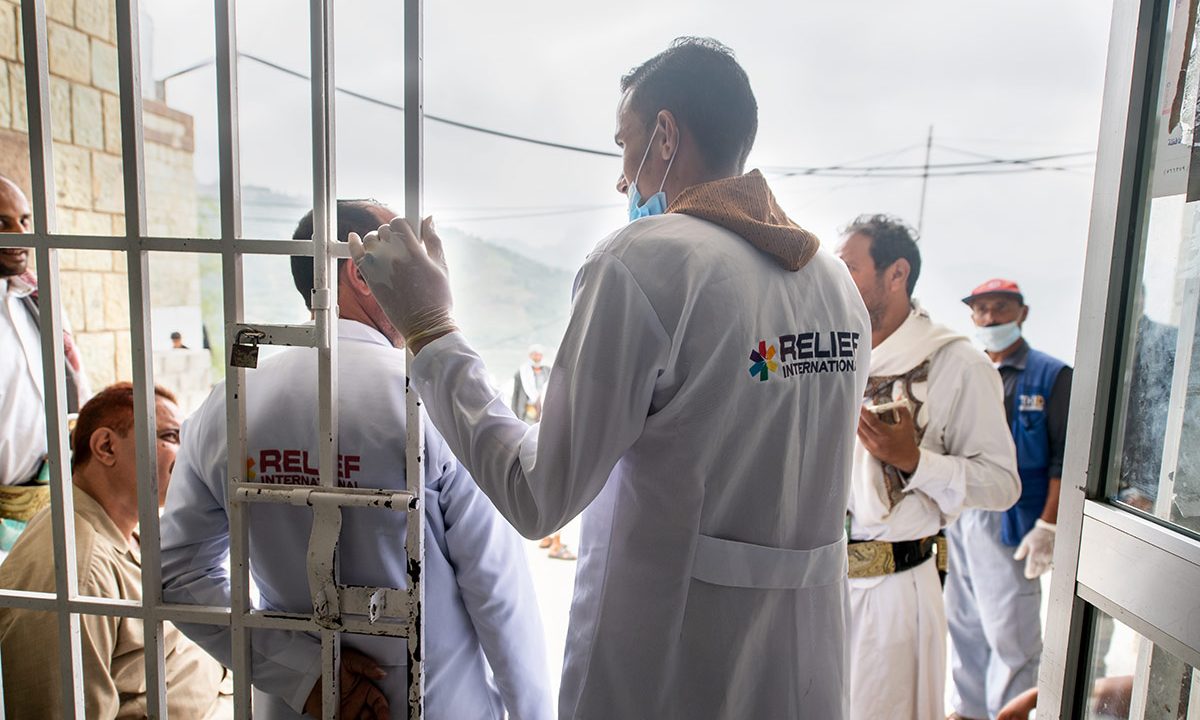The country’s health system is not equipped to handle the added strain of a global pandemic. With half of the country’s hospitals and health clinics damaged or destroyed by war, many requiring urgent medical attention will be unable to access it.
Relief International is working nonstop to prevent the spread of the novel coronavirus by providing essential protective gear, emergency healthcare services, and accurate information about symptoms and prevention measures.
Here are five things you need to know about the COVID-19 outbreak unfolding inside Yemen:
COVID-19 has taken hold in Yemen
The first case of COVID-19 was confirmed in Yemen on April 10. Since then, cases have surged across the country against the backdrop of a worsening conflict, water and food shortages, and a subsequent cholera outbreak.
“The country’s already broken health system is the biggest challenge we face in stopping the spread of COVID-19,” shares Relief International’s Health and Nutrition Technical Advisor Sari Elhaj.
With more than 3.5 million people displaced from their homes, the virus is spreading rapidly throughout overcrowded informal settlements. Many families do not have access to safe and clean water to drink or bathe — let alone wash their hands multiple times a day – making it extremely difficult for them to protect themselves against COVID-19.
There is almost no testing in Yemen
As of July 31, there are only 1,726 confirmed cases of COVID-19 in Yemen. However, the true toll of the pandemic is likely far greater. Given the extremely limited healthcare services available in Yemen, experts have warned that the outbreak of COVID-19 in Yemen would be a worst-case scenario.
“There is a shortage of tests available in Yemen, and that coupled with the country’s broken healthcare system, makes the virus untraceable. It is spreading rapidly across the country at a far greater rate than the official count suggests,” shares Sari.
Most patients who are being tested are already showing severe symptoms. They are in need of advanced medical care and most require immediate support to breathe. This reality has resulted in a death rate that is significantly higher than the global average, and it is impossible to know the true toll of the pandemic at this stage.

Years of war have caused severe damages to Yemen's healthcare system, which is now especially vulnerable to the strains of the coronavirus pandemic.
© RI/ Mohammed Al-Mkhlafi
Misinformation about COVID-19 is spreading as quickly as the virus
As COVID-19 spreads rapidly across Yemen, widespread fears of the coronavirus are preventing people from seeking medical care.
According to our staff, many people regard hospitals and health facilities as unsafe and as a potential source of infection. Recent reports have noted that the infection rate among health workers has significantly increased.
Others are afraid of the stigma that comes with testing positive for the virus. These concerns have caused many Yemenis to delay seeking treatment for their symptoms until their condition becomes life-threatening.
“Five years of fighting nearly destroyed the country’s health system. Now, with the outbreak of COVID-19, the collapse is complete as many health facilities are closing their doors for fear of the virus.”
A Shortage of PPE
To make matters worse, any available healthcare services are now under threat as a shortage of protective personal gear makes it impossible for health workers to do their jobs safely.
“There is a massive need for personal protective equipment in outbreak hotspots across Yemen,” shares Sari. “There is a shortage of protective gear at all levels — but most notably, inflated prices prevent many from being able to afford these life-saving supplies. Three months ago, a pack of masks would have cost $5 – but now the price has risen sixfold.”
The lack of personal protective equipment is driving many health workers to leave the country or avoid working for fear of contracting the virus given the little available protection.

Our staff are working to prepare health facilities to receive COVID-19 cases while also working in at-risk communities to provide information on how to prevent the spread of COVID-19.
© RI/ Mohammed Al-Mkhlafi
The next few months are critical
The country’s health system was already incredibly damaged by years of war. Now, the pandemic has pushed many people to lose confidence in health facilities and health staff.
Relief International is doing all we can to keep our regular health, food security, and cash assistance programs up and running while also responding to the growing needs of the pandemic. Our priorities are to increase awareness about how to prevent the spread of the virus in at-risk communities, preparing health facilities to handle an influx of COVID-19 cases, and providing protective medical gear to frontline health workers.
These are just a few of the ways that Relief International is responding to the outbreak of COVID-19 in the world’s most fragile setting. However, we cannot do this important work alone – especially as humanitarian funding for Yemen has fallen significantly this year, covering only a fraction of the needs on the ground.
